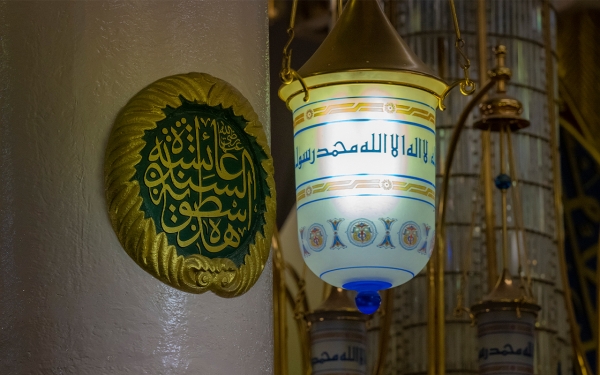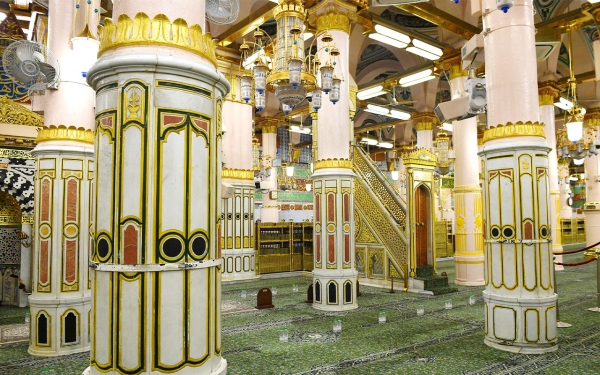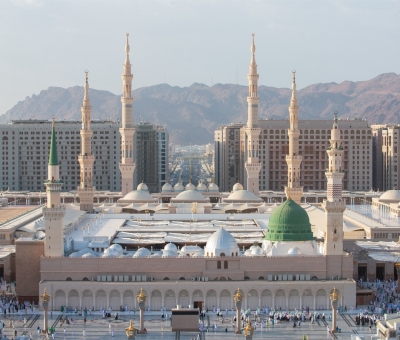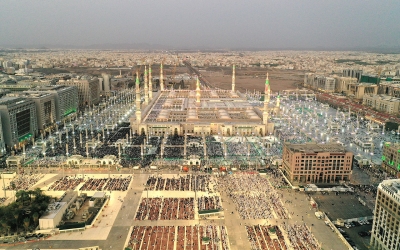



The pillars of the Prophet’s Mosque (Arabic: asateen, the plural form of ustuwanah) refer to the pillars and columns that served as the foundation for the construction of the Prophet’s Mosque during Prophet Muhammed's life. These comprised trunks of palm trees, and the columns that replaced them after the successive expansions and enlargements conducted at the mosque are called sawari (the plural form of sariyah), meaning poles.
Upkeep of the Pillars of the Prophet's Mosque
Officials overseeing enlargements of the Prophet's Mosque in previous times were keen on identifying the locations of the original pillars and preserving them by replacing them with modern ones and maintaining their original names. The pillars in the mosque's Qiblah have been renewed until this day.
Designations of the Pillars of the Prophet's Mosque
Pillars of the Prophet's Mosque are identified by the names inscribed on each of them, telling the story of their association with events of the Prophet's biography, namely: al-Mukhallaqah Pillar; Pillar of Aisha, also known as al-Qur’ah Pillar (casting lots) or al-Muhajireen Pillar (Emigrants); al-Tawbah Pillar (Repentance), also known as Pillar of Abu Lubabah; al-Sareer Pillar (Bed); al-Mahras Pillar (guard post); al-Wufood Pillar (Delegations); Marba’at al-Qabr Pillar (Square Pillar of the Tomb); and al-Tahajjud Pillar (the Night Vigil).
Al-Mukhallaqah Pillar
Al-Mukhallaqah Pillar is one of the most famous features of the Prophet's Mosque. It means the perfumed or the fragrant, and is situated adjacent to the Prophet’s mihrab towards the Qiblah. The pillar’s fame derives from replacing the tree trunk that wept when the Messenger of Allah peace be upon him (PBUH) began using the pulpit (minbar) and stopped climbing on it to publicly address Muslims.
Al-Qur’ah Pillar
Al-Qur’ah Pillar, or the Pillar of Aisha (may Allah be pleased with her), is situated third from the direction of the minbar, al-Qabr, and Qiblah. It got its name throughout history because Aisha told Abdullah Bin al-Zubair that this pillar was in a blessed location, so he went and prayed there. Hence, it became known as the Pillar of Aisha.
Al-Tawbah Pillar
The fourth pillar from the direction of the minbar, the second from al-Qabr, and the third from the Qiblah, is known as the Pillar of Abu Lubabah; namely Rifa’a Bin Abdulmunzer (may Allah be pleased with him), who tied himself to a palm tree trunk inside the Prophet’s Mosque (al-Tawbah Pillar), and refused to be untied until the Messenger of Allah (PBUH) untied him himself.
Al-Sareer Pillar
To the east of al-Tawbah Pillar, we find al-Sareer Pillar, adjacent to the window overlooking the Holy Raudah. It was a place of seclusion for Prophet Muhammed (PBUH), who used to lie on his bed in that location.
Al-Mahras Pillar
Al-Mahras Pillar is opposite the small door from which the Messenger of Allah (PBUH) used to exit to the Holy Raudah for prayer when he was in Aisha’s (may Allah be pleased with her) quarters. It was named the Pillar of Ali Ibn Abu Talib because he used to stand guard there to watch over the Prophet (PBUH).
Al-Wufood Pillar
Al-Wufood Pillar is located behind al-Mahras Pillar from the north. Prophet Muhammed (PBUH) used to sit there to meet delegates arriving to meet him.
Marba’at al-Qabr Pillar
Marba’at al-Qabr Pillar is located inside the wall surrounding the holy tomb, and therefore visitors cannot see it. It is also known as the Pillar of the Station of Jibril (Maqam Jibreel), at the door leading to the house of Fatimah (may Allah be pleased with her), the daughter of the Messenger of Allah (PBUH).
Al-Tahajjud Pillar
Al-Tahajjud Pillar is situated behind the house of Fatimah, the daughter of the Messenger of Allah (PBUH). A marble plaque on this pillar reads: ‘Here is the location where the Prophet of Allah (PBUH) used to perform the night vigil prayer.’
Related quizzes

